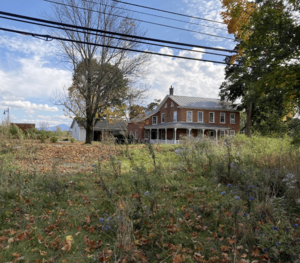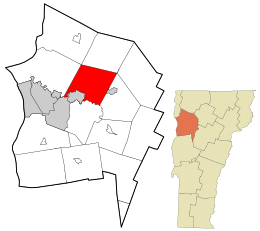Essex, Vermont facts for kids
Quick facts for kids
Essex, Vermont
|
|
|---|---|
 |
|
| Motto(s):
"Crossroads of Chittenden County"
|
|

Location in Chittenden County and the state of Vermont.
|
|
| Country | United States |
| State | Vermont |
| County | Chittenden |
| Incorporated | June 7, 1763 |
| Communities | Essex Center Butlers Corners Pages Corner |
| Area | |
| • Total | 39.3 sq mi (101.8 km2) |
| • Land | 38.8 sq mi (100.6 km2) |
| • Water | 0.5 sq mi (1.3 km2) |
| Elevation | 486 ft (148 m) |
| Population
(2020)
|
|
| • Total | 22,094 |
| • Density | 562.11/sq mi (217.03/km2) |
| Time zone | UTC−5 (Eastern (EST)) |
| • Summer (DST) | UTC−4 (EDT) |
| ZIP codes |
05451-05452
|
| Area code | 802 |
| FIPS code | 50-24175 |
| GNIS feature ID | 1462091 |
Essex is a town located in Chittenden County, Vermont, United States. A major road, Vermont Route 289, runs through the town from east to west. Until 2022, the city of Essex Junction was a village within Essex.
Contents
History of Essex
Essex became an official town on June 7, 1763. It was named after the Earl of Essex, a noble title from England.
Essex Junction Village Formation
The Village of Essex Junction was created within the town of Essex on November 15, 1892. This happened because the people living in the village wanted more services. These services included things like sidewalks, water systems, and sewers. The people in the more rural parts of the town did not want these services, or the extra taxes that came with them.
Attempts to Merge Essex and Essex Junction
Over the years, as the town outside the village grew, it also started to add similar services. By 1958, people began suggesting that the town and village should merge. There were many votes over the years about merging. These votes were often difficult and caused disagreements. A merger needed to pass in both the village and the town to happen.
On November 7, 2006, a merger vote passed in both the town and the village. However, there was some confusion. A local newspaper incorrectly reported that the merger had failed. The next day, the correct results were shared, showing that it had actually passed.
Because of the confusion and close results, a petition was started to vote on the merger again. This new vote happened on January 23, 2007. This time, the merger was rejected by a small number of votes. If it had passed, it would have started a long process to create a new "Town of Essex Junction." This new town would have replaced the separate governments of Essex and Essex Junction.
Essex Junction Becomes a Separate City
On November 2, 2021, voters in Essex Junction decided to separate from the town of Essex. They felt they were paying too much in taxes compared to the services they received. The vote was strongly in favor of separation. Essex Junction officially became its own city on July 1, 2022.
Geography of Essex
Essex is located in the middle of Chittenden County. The Winooski River forms its southern border.
Neighboring Areas
Essex is surrounded by several other towns and cities. To the west is Colchester. Milton is at the northwest corner, and Westford is to the north. At the northeast corner is Underhill, and Jericho is to the east. To the south is Williston. The cities of South Burlington and Essex Junction are to the southwest.
Land and Water
The town of Essex covers a total area of about 101.8 square kilometers (39.3 square miles). Most of this area, about 100.6 square kilometers (38.8 square miles), is land. The remaining 1.3 square kilometers (0.5 square miles) is water, making up about 1.26% of the town's total area.
Natural Areas
Essex is home to two important natural spaces. The Indian Brook Town Conservation Area is 575 acres large. The Saxon Hill Town Forest covers 335 acres. These areas help protect nature and offer places for outdoor activities.
Population and People
| Historical population | |||
|---|---|---|---|
| Census | Pop. | %± | |
| 1790 | 354 | — | |
| 1800 | 729 | 105.9% | |
| 1810 | 957 | 31.3% | |
| 1820 | 1,089 | 13.8% | |
| 1830 | 1,664 | 52.8% | |
| 1840 | 1,824 | 9.6% | |
| 1850 | 2,052 | 12.5% | |
| 1860 | 1,906 | −7.1% | |
| 1870 | 2,022 | 6.1% | |
| 1880 | 2,104 | 4.1% | |
| 1890 | 2,013 | −4.3% | |
| 1900 | 2,203 | 9.4% | |
| 1910 | 2,714 | 23.2% | |
| 1920 | 2,449 | −9.8% | |
| 1930 | 2,876 | 17.4% | |
| 1940 | 3,059 | 6.4% | |
| 1950 | 3,931 | 28.5% | |
| 1960 | 7,090 | 80.4% | |
| 1970 | 10,951 | 54.5% | |
| 1980 | 14,392 | 31.4% | |
| 1990 | 16,498 | 14.6% | |
| 2000 | 18,626 | 12.9% | |
| 2010 | 19,587 | 5.2% | |
| 2020 | 22,094 | 12.8% | |
| U.S. Decennial Census | |||
Population in 2010
In 2010, the town of Essex had 19,587 people living in 7,322 households. Most of the people, about 91.6%, were non-Hispanic White. Other groups included 1.5% Black or African American, and 3.2% Asian. About 1.7% of the population was Hispanic or Latino.
The average household had 2.62 people. About 38.5% of households had children under 18 living there. The median age of people in Essex was 36 years old. About 27.9% of the population was under 18 years old.
Arts and Culture
Museums and Points of Interest
The Harriet Farnsworth Powell Museum is located in Essex. This museum is in an old two-room schoolhouse. It has a collection of old clothes, school items, and things that show the local history of Essex.
Media
The Essex Reporter is a newspaper published every week in Essex. It shares news from Essex and nearby communities in Chittenden County. About 8,800 copies of the newspaper are printed each week.
Infrastructure
Transportation in Essex
Vermont Route 289, also known as "The Circ," goes through Essex. The part of this highway within Essex is finished. However, building more of the highway in other towns was stopped by environmental groups.
Bus services in Essex are provided by Green Mountain Transit.
Rail Travel
Amtrak, the national passenger train system, offers daily train service. The train station is in nearby Essex Junction. The Vermonter train travels between St. Albans, Vermont, and Washington, D.C. In 2008, a study found that taking the train was the cheapest way to get from the Burlington area to New York City. It cost about $48, but it was also the longest trip, taking around 9 hours and 25 minutes.
Notable People
- Bert Abbey (1869–1962), a baseball pitcher for teams like the Washington Senators and Brooklyn Grooms/Bridegrooms.
- William B. Castle, who served as the mayor of Cleveland, Ohio.
- Linda K. Myers, a member of the Vermont House of Representatives.
See also
 In Spanish: Essex (Vermont) para niños
In Spanish: Essex (Vermont) para niños


